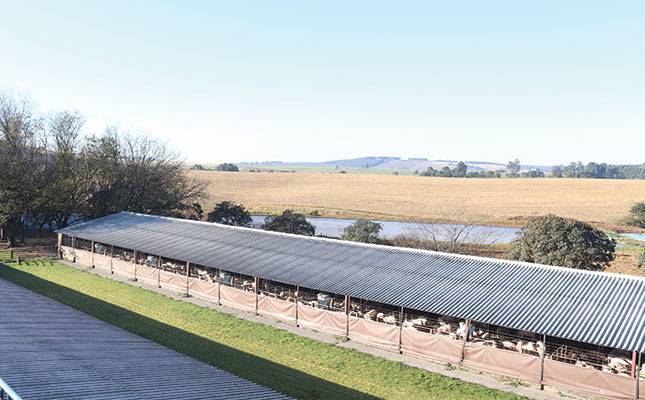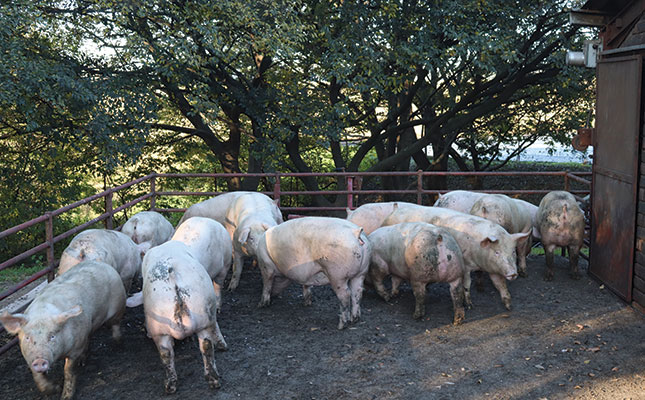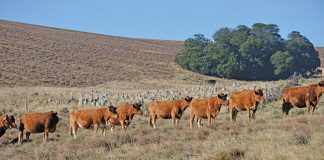
Photo: Lindi Botha
Rising input costs and stagnant farm gate prices forced Philip Benson, co-owner of the Benson Group in Karkloof, KwaZulu-Natal, to take a hard look at the family business and assess its viability.
A second-generation farmer, Benson took over the running of the piggery started by his father, Mike, who established a renowned stud farm, Hogan Stud, supplying high-quality genetics to both his own and other piggeries.
“My father was instrumental in bringing new genetics into the country, and was the first to bring Durocs into South Africa. But as a breeding company, we were small compared with internationally based genetic companies.
READ Marketing and animal welfare: key to success
“In time, we realised that we couldn’t compete, particularly in terms of the amount of money they spent on constantly improving their genetics,” recalls Benson.
It was at this point, four years ago, that Benson realised they would have to set aside sentiment if the business were to move forward.
“I realised we just wouldn’t reach the genetic potential [we were aiming for] unless we used one of the bigger genetic suppliers. It was a sobering moment for us. But the pig industry is challenging, and if you’re not farming top genetics, you just won’t make it.”
The Benson Group began bringing in genetics from breeding company PIC, whose slogan is ‘Never stop improving’.
“They really don’t!” says Benson. “We’ve seen a big improvement in our production since we started using their genetics, both in terms of output and sow conception rates. The combination of our old Hogan genetics and those of PIC has worked well for us.”
The genetics used are those of PIC 410, and PIC 337 is also gradually being introduced. Joe Gates, manager of the 850 pigs at the Benson piggery, says PIC 410 provides big hams and shoulders in their progeny.
“Growth rates and carcass traits are also superior, as PIC 410 provides good muscling. In addition, the herd is far more resilient, resulting in healthier, robust pigs. Feed conversion in PIC 410 offspring is good, at 2,4kg of feed for a 1kg weight gain, and even further improved in those of PIC 337.”
Benson says that, in the past, consumers complained that pork had too much fat, but newer genetics have greatly reduced fat content. Improved genetics have also resulted in animals with larger shoulders and less hair, traits sought after by abattoirs.
“Having the right genetics means you can give everyone in the market what they’re looking for, keeping your product in demand,” he says.
The group has also made strides in productivity over the past four years, increasing the number of piglets farrowed per sow by an average of 3,5 a year. Litters per sow, too, have increased, and now average 2,4 a year. Benson says that although they have seen dramatic improvements in production, the piggery is still not amongst the best in the industry.
“An added bonus of working with a big company like PIC is that they do industry benchmarking, so we can see where we rank and where we still need to improve.”
Steady production
Benson strives to achieve an efficient, profitable and highly productive piggery. A steady flow of pigs ready for slaughter means a steady cash flow, and sows are therefore inseminated each week with semen flown in from PIC.
The farm handles farrowing to finishing, inseminating 38 sows and gilts selected from within the herd every week. They are then moved from the service house to gestation crates, where they remain for three weeks, and thereafter proceed to group housing, where they stay until a week before farrowing.

Once moved to the farrowing house, they stay there for 28 days before starting the cycle again in the service house.
Weaning takes place at 28 days, and about 400 pigs are weaned each week. After six weeks in the weaner house, they are moved to a grower unit. Up until about four years ago, the piglets went from the farrowing house to a follow-on house and only then to the weaning house, but this step was eliminated in a bid to reduce stress.
“Each time you move pigs, they become stressed, and you lose production. We therefore keep them a little longer in the farrowing house, then send them straight to the weaner house. This was part of the process we underwent to improve efficiency.”
At 22 weeks of age, when their average carcass weight is 81kg, the pigs are sent for slaughter.
“Previously, we were slaughtering out quite light, at about 72kg at 20 to 21 weeks, because we were short on space,” explains Gates. “But since upgrading our facilities, we’ve been able to extend the slaughter age to 22 weeks, adding 9kg in the process.
“The weight gain is due not only to the extra time, but to better genetics. Over the past four years, our 10-week-old weaners have increased from an average of 27kg to 30kg.”
Benson adds: “We want to achieve a heavier carcass, because we’d be throwing good money after bad if we sold our carcasses too light, in the shortest possible time. We aim for a heavier carcass at 22 weeks.”
One of the greatest challenges in pig farming is to ensure steady production. As Benson puts it: “You should almost literally be catching your piglets from the sows as you move the sows into the farrowing houses.”
This will ensure that space is neither being under- nor over-utilised on the farm. It also means that the customer will have a steady supply of meat, and the farmer a consistent cash flow.
Weaners, nonetheless, are highly vulnerable and require special attention to keep the mortality rate as low as possible.
“Animals are stressed when they’re weaned because they’re removed from their mothers and placed with a new group of pigs, where there can sometimes be fighting. This is the most crucial time to keep a watchful eye on the pigs. There’s a natural hierarchy, so the pigs should be kept in the same group throughout their life cycle. They get used to each other and don’t have to readjust to new animals.”
Better genetics have also led to more robust, energetic pigs that require extra management. ‘Toys’ are therefore kept in the pens to keep the animals occupied.
“They like to chew on something, so we give them gumboots or tyres. These pigs definitely have more vigour. You can see when they’re born that they’re raring to go. They look for the teats and drink vigorously, which is what we want. We don’t want listless pigs,” explains Benson.
Reducing the feed bill
With feed costs rising significantly on the back of record-high maize prices, the Benson Group has an added advantage in that it has 200ha planted to dryland maize, which ensures enough maize to feed the pigs for eight months of the year. The maize is fertilised with manure from the piggery, which not only helps to bring down the fertiliser bill, but also increases yield.
The manure has been especially helpful in lifting yields on lands that were previously marginal.
The feed consists of a mixture of maize, bran, soya oilcake, full-fat soya, and nutrient packs dependent on the growth stage.
Since rainfall and the incidence of hail are too high to plant soya bean, this needs to be bought in, in addition to maize for the other four months of the year.
Benson says the current fluctuations in prices make it difficult to calculate the profitability and sustainability of the business.
“This year, maize has been landing on the farm at R5 000/t, up from last year’s R3 500/t. And the price we’re getting for our pigs this year is lower than last year’s. This has made pig farming enormously challenging. Because 75% of costs are attributed to feed, the feed conversion ratio plays a major role in profitability. And this is very much attributed to genetics, which makes it even more important to farm the best.
“Producers who are not growing their own maize have very little control over their feed costs. We’re all beholden to global markets, so it’s important to ensure that the feed provides maximum output.”
Most of the feeding procedure at the Benson piggery takes place automatically. The switch to this was triggered by a labour strike in 2010.
“We were employing about 150 people at the time and have reduced the number to 89. We realised then that we couldn’t be fully reliant on staff in that way, and at the mercy of their whims. The change to automatic feeding has also enabled us to use smaller feeding troughs, with feed added more regularly. This means the pigs have access to fresh feed more often. Feeding has become far more efficient and we can cope better over weekends and on holidays,” says Benson.
Healthier pigs
When scrutinising the business four years ago, the group also reviewed the health programme of the pigs. Gates says the medicine bill was rather high due to the high prevalence of disease.
“We realised we couldn’t continue dosing the pigs the way we were. So we started a process of elimination, with the help of our veterinarian, to see what was really making a difference to the herd’s health and what was simply excessive.
READ Focus shifts from zinc to gut health for robust pigs
“We soon found that we could go without some medication. Because of the global movement towards less antibiotic use in meat production, we decided to pull routine antibiotics from the programme as well. The pigs didn’t seem to miss them. We’re now spending much less on medication than in the past.”
Benson concurs that it’s crucial to avoid unnecessary medication and to get the right advice in this respect. “With the Pork360 programme that’s implemented in South Africa, we must account for every needle and every drop of medicine. This helps to keep us on our toes and guarantee healthy meat for the consumer.”
The farm doesn’t use growth stimulants and is in the process of eliminating zinc oxide from the pigs’ feed. Gates keeps a close eye on developing trends internationally, aiming to emulate them before they become compulsory and the farm is forced to make overnight changes.
The movement towards reducing the time that sows spend in farrowing crates has seen the Benson piggery cut this period to four weeks from the industry standard of five. And with the implementation of newer, more modern crates, pre-weaning mortality has decreased by 4% to reach 11,5%.
Rethinking suppliers
Benson reflects that past loyalties have not always stood them in good stead, and the move to take sentiment out of the business saw them overhaul their suppliers’ list.
“We’ve been in business for 50 years, so have become friends with our suppliers. But taking the emotion out of the business meant relooking costs, and we realised we couldn’t afford to not get the best prices anymore. Keeping your head above water is all about being efficient.
“If we hadn’t made the changes we did four years ago (getting better genetics, using less medicine, shopping around for lower input costs) we wouldn’t be here today. Our production would have been too low, and we wouldn’t be getting the quality and quantity of carcasses that would have seen us through. We’ve been able to turn the ship around and it has been a very rewarding journey.”
Email Joe Gates at [email protected].











